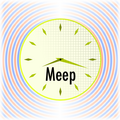Meep C-plus-plus Tutorial
From AbInitio
| Revision as of 01:53, 23 October 2005 (edit) Ardavan (Talk | contribs) ← Previous diff |
Revision as of 02:08, 23 October 2005 (edit) Ardavan (Talk | contribs) Next diff → |
||
| Line 38: | Line 38: | ||
| } | } | ||
| + | We are now ready to set up the computational area, excite the sources, and compute the resulting quality factor. Here we set up the main part of the control file, as with any C/C++, incorporating classes and sub routines. | ||
| + | |||
| + | int main(int argc, char **argv) { | ||
| + | double amicron = 20; | ||
| + | volume vol = vol2d(2*x_center,2*y_center, amicron); | ||
| + | structure s(vol,eps,pml_thickness); | ||
| + | fields f(&s); | ||
| + | const double wavelength = 1.72; | ||
| + | const double freq = 1.0/wavelength; | ||
| + | |||
| + | The sources in Meep are excitations of the polarization vector in D=\epsilonE+P. The polarization can be any one of the six cartesian or cylindrical fields. There are a variety of sources including gaussian pulses and continuous wave source. For now, we use the default dipole source for the TM mode consisting of the Ez, Hy, Hx fields. | ||
| + | |||
| + | f.add_point_source(Ez, freq, width, 0, 5.0, v.center()); | ||
| + | |||
| + | The parameters to the add_point_source function of the fields class are, in order, the frequency, width, start time, peak time and the location of the excitation in the computational cell. Here we make use of the built in function, v.center(), that automatically computes the geometric center of the of the computational volume. | ||
| + | |||
| + | |||
| [[Category:Meep]] | [[Category:Meep]] | ||
Revision as of 02:08, 23 October 2005
| Meep |
| Download |
| Release notes |
| FAQ |
| Meep manual |
| Introduction |
| Installation |
| Tutorial |
| Reference |
| C++ Tutorial |
| C++ Reference |
| Acknowledgements |
| License and Copyright |
Computing the Quality Factor of a Resonator
In this first tutorial, we will write the script to compute the quality factor of a cavity in 2D cartesian co-ordinates. The control file will be a C++ file (having extension *.cpp). In order to use all the classes and subroutines available in Meep, the first two lines of any control file must be the following:
#include <meep.hpp> using namespace meep;
The particular cavity we will investigate is 1D waveguide bounded by two distributed bragg reflectors whose parameters we set up as follows:
const double half_cavity_width = 0.5*0.68; const double air_slit_width = 0.38; const double grating_periodicity = 0.48; const double half_waveguide_width = 1.0; const double num_air_sluts = 15.0; const double high_dielectric = 12.0; const double low_dielectric = 11.5;
Meep supports periodic matching layers (PML) and absorbing boundary conditions. The PML begins at the edge of the computational cell/volume and works inwards. Hence, we specify the size of the computational cell as follows:
const double pml_thickness = 1.0; const double x_center = 7.7 + pml_thickness; const double y_center = 10.5 + pml_thickness;
To specify a dielectric structure in Meep, we define a function that takes as input one parameter, a position vector, and returns the value of the dielectric at that position.
double eps(const vec &p) {
const vec r = p - vec(v_center, y_center);
double dx = fabs(r.x() - half_cavity_width);
if (dx > 0 && dx < num_air_slits*grating_periodicty) {
while (dx > grating_periodicity) dx -= grating_periodicity;
if (dx < air_slit_width) return 1.0;
}
if (fabs(r.y()) < half_waveguide_width)
return high_dielectric;
else
return low_dielectric;
}
We are now ready to set up the computational area, excite the sources, and compute the resulting quality factor. Here we set up the main part of the control file, as with any C/C++, incorporating classes and sub routines.
int main(int argc, char **argv) {
double amicron = 20;
volume vol = vol2d(2*x_center,2*y_center, amicron);
structure s(vol,eps,pml_thickness);
fields f(&s);
const double wavelength = 1.72;
const double freq = 1.0/wavelength;
The sources in Meep are excitations of the polarization vector in D=\epsilonE+P. The polarization can be any one of the six cartesian or cylindrical fields. There are a variety of sources including gaussian pulses and continuous wave source. For now, we use the default dipole source for the TM mode consisting of the Ez, Hy, Hx fields.
f.add_point_source(Ez, freq, width, 0, 5.0, v.center());
The parameters to the add_point_source function of the fields class are, in order, the frequency, width, start time, peak time and the location of the excitation in the computational cell. Here we make use of the built in function, v.center(), that automatically computes the geometric center of the of the computational volume.

